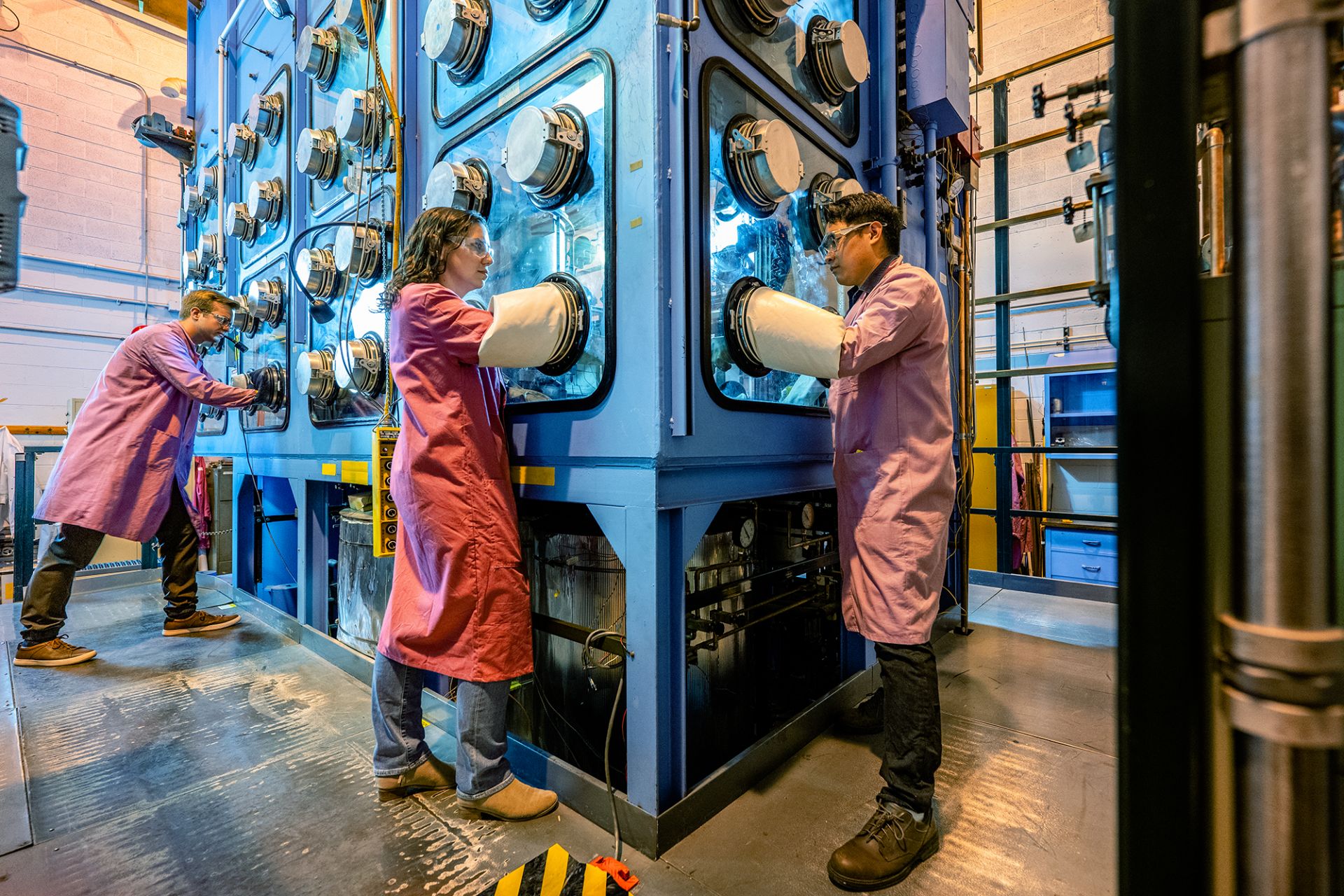Engineers in Argonne’s Chemical and Fuel Cycle Technologies Division. (Photo: Argonne National Laboratory)
Oklo Inc. announced that it has completed the first end-to-end demonstration of its advanced fuel recycling process as part of an ongoing $5 million project in collaboration with Argonne and Idaho National Laboratories. Oklo’s goal: scaling up its fuel recycling capabilities to deploy a commercial-scale recycling facility that would increase advanced reactor fuel supplies and enhance fuel cost effectiveness for its planned sodium fast reactors.
The NWMO’s Laurie Swami (center right) congratulates Ignace mayor Kim Baigrie (center left) on the community’s confirmation of its willingness to host a deep geologic repository for Canada’s spent nuclear fuel. (Photo: NWMO)
The township of Ignace in northwestern Ontario has indicated its willingness to host a potential deep geologic repository for Canada’s spent nuclear fuel. The town council voted unanimously on July 10 to pass a resolution indicating its willingness to participate in the Nuclear Waste Management Organization’s (NWMO's) process for selecting a repository site, making it the first Canadian community to officially move forward with the next phase of a site selection process that began in 2010.
Workers at the Hanford Site’s WTP unload a tanker truck carrying sodium hydroxide. (Photo: DOE)
Workers at the Department of Energy’s Hanford Site in Washington state recently unloaded a shipment of more than 10,000 gallons of sodium hydroxide delivered to the site’s Waste Treatment and Immobilization Plant (WTP). The liquid sodium hydroxide will be the first chemical fed into the plant’s melters to simulate Hanford’s radioactive and chemical tank waste.
Concept art of Holtec’s proposed HI-STORE CISF in New Mexico. (Image: Holtec)
Holtec International announced that it has petitioned the U.S. Supreme Court to overturn the Fifth Circuit’s March 2024 ruling that vacated the license for the company’s HI-STORE consolidated interim storage facility (CISF) for commercial spent nuclear fuel in southeastern New Mexico.
Construction crews finish work on large ductwork for WIPP’s new SSCVS facility. (Photo: DOE)
The Department of Energy’s Office of Environmental Management announced that it has completed construction of the new large-scale ventilation system at its Waste Isolation Pilot Plant in New Mexico.
All major concrete placements have been completed on Saltstone Disposal Unit 10, the latest megavolume disposal unit being built at the Savannah River Site. This aerial view shows the final roof section being installed on the unit. (Photo: DOE-EM)
With the placement of 25 wall sections, 208 support columns, and 7 roof sections, work crews have completed all major concrete placements for the megavolume Saltstone Disposal Unit (SDU) 10 at the Savannah River Site in South Carolina, according to the Department of Energy’s Office of Environmental Management.
Stephanie Doll of WRPS poses next to the metal patch applied during the demonstration. (Photo: DOE)
The Department of Energy’s Office of Environmental Management and its contractor Washington River Protection Solutions (WRPS) recently demonstrated the use of cold spray technology as a means of refurbishing double-shell waste tanks at the Hanford Site in Washington state. The tanks store liquid radioactive and chemical waste that was created during Hanford’s plutonium production era.
The Atlas railcar carries a test load simulating a shipment of spent nuclear fuel. (Photo: DOE)
The Department of Energy’s Office of Nuclear Energy announced last week that the Association of American Railroads has certified its Atlas railcar system to operate on all major freight railroads in the United States.
Watch a video of the Atlas railcar development here.
The Materials and Fuels Complex at INL. (Photo: INL)
The Department of Energy will enter into lease negotiations with two solar energy developers for 400 megawatts of solar electricity generation within the Idaho National Laboratory site. Announced on June 5, the projects are the first proposed projects selected under the department’s Cleanup to Clean Energy initiative, an effort to repurpose parts of DOE-owned lands—portions of which were previously used in the nation’s nuclear weapons program—into sites of clean-energy generation, including for solar, geothermal, wind, and nuclear.
Transmutex’s transmutation reactor. (Image: Transmutex)
Switzerland’s national cooperative for the disposal of radioactive waste, Nagra, is distancing itself from recent reports regarding the work of the Geneva-based engineering start-up Transmutex, which claims to have developed a new technology for the transmutation of radioactive waste.
The Savannah River Site’s shielded canister transporter. (Photo: DOE)
The large vehicle used to transport highly radioactive canisters at the Department of Energy’s Savannah River Site has completed a pit stop to ensure the continued movement of the site’s radioactive liquid waste work.
Lourdes Legaspi, engineering automation supervisor (center) and her team are designing pipe and equipment components for the Hanford Site’s partially completed HLW Facility. A collaboration between the DOE and Bechtel National set a foundation for requirements engineers will follow in continuing the design of the facility. (Photo: DOE)
The Department of Energy’s Office of Environmental Management announced that its Office of River Protection (ORP) recently created a plan with contractor Bechtel National for completing the High-Level Waste Facility at the Hanford Site’s Waste Treatment and Immobilization Plant, also known as the Vit Plant.
A 125-foot-tall exhaust stack towers over the Safety Significant Confinement Ventilation System’s filter building at the Waste Isolation Pilot Plant. (Photo: DOE)
The Defense Nuclear Facilities Safety Board (DNFSB), an independent government organization responsible for overseeing public health and safety issues at Department of Energy defense nuclear facilities, has alerted the DOE because of safety concerns it has regarding the use of continuous air monitors (CAM) at the Waste Isolation Pilot Plant in New Mexico.
Part of WIPP’s new Safety Significant Confinement Ventilation System (SSCVS), the CAM system is intended to detect a radiological release in the repository and automatically close vent dampers to prevent the escape of radioactive particles to the outside environment. The SSCVS, which began commissioning in November 2023, is intended to increase airflow to the underground to allow for simultaneous underground waste emplacement, mining, and ground control work.














